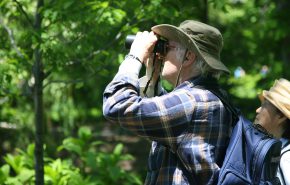Recent estimates from the U.S. Fish and Wildlife Service (FWS) report that U.S. populations of the Bald Eagle have quadrupled over the last 10 years. “This increase in Bald Eagle populations is quite encouraging, and may often lead to a need for increased diligence by energy developers and other GAI clients to minimize the potential for conflict with eagles,” said GAI Environmental Manager Matthew White, MS.
Gains for fragile wildlife like the Bald Eagle are owed in large measure to governmental regulations protecting rare, threatened, and endangered (RTE) species. GAI-provided protected wildlife searches and mitigation services including gopher tortoise searches and relocation, bat studies, and, in the case of our national bird, aerial Bald Eagle nest search and other bird occurrence services enable clients’ project work to proceed in a timely manner and facilitate compliance with federal and state requirements.
Endangered Wildlife Regulations Affect a Range of Project Work
Many of the regulations that govern a project’s impact on the Bald Eagle and other RTE species stem from the federal Endangered Species Act of 1973 (ESA). Administered by the FWS and National Marine Fisheries Service (NMFS), the ESA was designed to protect critically imperiled species from extinction. Additionally, individual states often enforce their own RTE species-related regulations. Removed from the federal ESA in 2007, the Bald Eagle continues to be protected by both the federal Bald and Golden Eagle Protection Act and Migratory Bird Treaty Act.
“In addition to energy development and transmission projects, regulations governing RTE impacts can affect Department of Transportation (DOT) projects, projects that have federal funding or that that have a federal permit associated with them, and much more,” said White. “We help clients navigate the array of regulations that may affect project work and provide the environmental studies and services necessary to facilitate satisfying those regulations.”
Positive gains for RTE species like those recently reported for the Bald Eagle may result in adjustments to the regulations that apply to a variety of project work.
Aerial Bald Eagle Nest Search Speeds Regulation Compliance
“The object of an aerial Bald Eagle nest search is to document presence or absence, and when present, develop suggested mitigation measures to reduce the anticipated adverse impact of a client’s project on the species during its breeding season, so the species can continue to reproduce and raise its young,” said White. “It’s ideal to search in winter or the very beginning of eagle breeding season when the leaves are still off the trees making nests more readily visible.”
![]()
Bald Eagle populations primarily nest within 1 mile of sizable bodies of water like rivers, lakes, or reservoirs. “The areas we need to cover are often vast and can consist of some very rough terrain—and there are times when physical access to an area that we need to survey is not feasible,” said White. “For these reasons, client investment in a survey that utilizes a small plane or helicopter can pay dividends in terms of time and efficiency over a traditional foot survey.”
Read
Matt White’s discussion about bird surveys to detect endangered Loggerhead Shrikes that were aided by ‘crowd-sourced’ scientific data.Comprehensive Services, Coordinated Initiatives, Successful Outcomes
GAI’s protected wildlife assessments and mitigation work is a vital component in a comprehensive service set that can see a project through from origination to ongoing operation and maintenance. “When we are providing the engineering, the permitting, the environmental monitoring—many services wrapped into one—it allows us to further streamline the total project for the client,” said White. “The information I need in order to strategize fulfilling RTE compliance requirements is available to me quickly and efficiently, and I can provide results to fellow GAI colleagues who can more quickly and efficiently utilize my findings as needed. It’s gratifying to see things coming together to benefit the client in this way.”
It can also be gratifying to see how the larger effort to lessen impact on RTE species can benefit the environment. “As you can imagine, many people in my line of work came to the environmental field as a result of a life-long appreciation and affection for wildlife and nature,” said White. “News that work like ours may have a hand in such a successful and dramatic rebound in Bald Eagle populations gives me a true sense of personal accomplishment.”
Contact GAI Environmental Manager Matthew White, 317.436.4832, for more information about bird assessments and other GAI services offered throughout the U.S. that help conserve wildlife while being sensitive to project needs.
![]() Environmental Manager Matthew White, MS specializes in environmental permitting and compliance; wetland delineations and stream identifications; on-site and desktop siting of linear and non-linear projects; and rare, threatened, and endangered (RTE) species consultations, particularly habitat and presence/probable absence searches for birds.
Environmental Manager Matthew White, MS specializes in environmental permitting and compliance; wetland delineations and stream identifications; on-site and desktop siting of linear and non-linear projects; and rare, threatened, and endangered (RTE) species consultations, particularly habitat and presence/probable absence searches for birds.


